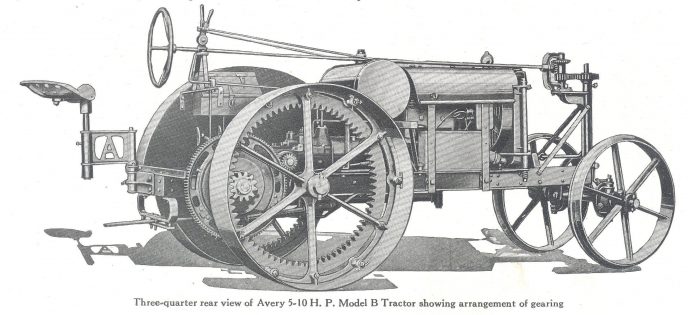Many years ago, at one of the tractor shows in Illinois or Iowa that I attended, I saw one of the cutest little steel-wheeled tractors I’d ever seen.
The machine that caught my eye and made me want to own one was an Avery 5-10 Model B, made by the Avery Co. of Peoria, Illinois, from about 1916 into maybe 1921.
Avery
The Avery Co., which began in the 1870s, was famous for its steam traction engines, especially the locomotive-style Avery Undermount, as well as the Avery “Yellow Fellow” separator.
As gas tractors became more popular in the early 1900s, Avery recognized the trend and developed an ungainly, 12,000-pound tractor with a single-cylinder engine of 12-inch bore and 18-inch stroke.
The machine made such a poor showing at the 1910 Winnipeg Tractor Demonstration that it was scrapped and Albert O. Espe was hired to design a better tractor.
Espe came up with the iconic Avery tractor design that featured a round, exhaust-draft radiator out front and a two- or four-cylinder opposed engine that was mounted on a sliding frame.
To shift the gears, a lever was used to slide the whole engine forward to disengage, then high or low speed or reverse was selected and the engine slid to the rear to engage the selected gear.
There was no transmission as such. The two-cylinder engine was used in the 8-16 and 12-25 models, while the 14-28, 18-36, 25-50, and 40-80 versions had four cylinders.
All but the 8-16 also featured the distinctive Avery cab over the operator’s platform.
When Henry Ford announced in 1916 that he was going to build a small, cheap tractor he shook up more than one tractor builder, Avery included. So to compete, Avery made a conventional small tractor called the Model “B” beginning about 1916 with a four-cylinder, in-line engine of 3 by 4-inch bore and stroke, a multiple disc clutch and a sliding gear, three-speed transmission.
Rated at 5-10 HP, the little 5-10 was just 50 inches wide, 54 inches high, 135 inches long and weighed 2,600 pounds.
In the 1919 catalog, Avery pointed out that, “Not long ago it was thought necessary to have a bonanza farm of 1,000 acres with no fences in the way to operate a tractor successfully. To farm 10 acres with a tractor was unheard of. But today the little Avery 5-10 H.P. Tractor is being used to do all the work on thousands of small farms and the lighter work on large farms. This tractor is specially designed for small farms, 50 acres or less; also for gardening, fruit growing, and for doing the lighter field, belt and hauling work on large farms.”
According to an article in the September 19, 1919, issue of Tractor World magazine, the 5-10 was equal to a three-horse team and would pull two 12-inch bottoms in stubble, or one 16-inch in heavy soil; an 8-foot disc or 3-section spike-tooth harrow; a grain drill, manure spreader, potato or corn planter, or a loaded farm wagon.
It could, if equipped with the optional belt pulley, drive a small ensilage cutter, corn sheller, baler, feed grinder, fanning mill, churn, cream separator, milking machine, wood saw, grindstone, washing machine or pump.
It could pull an orchard sprayer or a two-row cultivator, although there wasn’t a lot of ground clearance in so low a tractor, and, “in fact, its utility is limited largely by the ingenuity of its owner.”
Avery also made a motor cultivator, with the same four-cylinder engine as the Model “B,” but farmers never warmed to these implements although several manufacturers tried them.
Model C
About 1920, Avery added a six-cylinder Model “C” tractor that was nearly identical to the 5-10 except it was slightly larger and put out somewhat over eight drawbar horsepower at Nebraska.
At the same time a larger, six-cylinder motor cultivator was introduced, but these cultivating machines didn’t stay in the lineup for long.
Later, an adaptation of the motor cultivator that featured a 12-foot angle blade mounted between the front and rear wheels was introduced.
The machine was called the Avery “One-Unit” One Man Power Road Maintainer and attained some success with government road departments that had lots of dirt roads to maintain.
It had an approximately 6-foot shorter wheelbase than most other road patrols then being made and could thus be turned around much easier on the narrow country roads of the day.
Hard times
Avery fell on hard times due to the agricultural depression of the early 1920s and its lack of new, updated models — it was still using the original sliding engine gear change feature into the ’20s — and in 1923 the firm declared bankruptcy and went into receivership the next year.
A few of the company’s officers obtained backing and reconstituted the company, limping along with a new, all-steel thresher and the Road Maintainer until the Great Depression struck the final blow in 1931.
I kept an eye out for an Avery 5-10 for a couple of years and finally saw an ad for one in, I think, Antique Power magazine. It was in Iowa and was in running condition and the owner was asking $4,000 for the thing.
After a couple of phone calls and thinking about it, I decided the price was too high and passed it up. That’s only one of the many mistakes I’ve made over the years, as I never saw another for sale.














Too bad! One went for more than 47 thousand dollars in 2021!